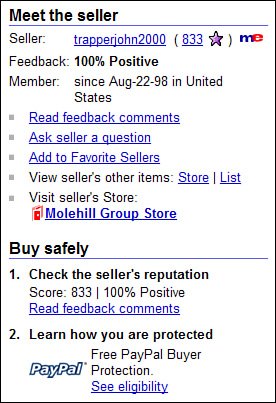| What do you do if you follow all this advice and still end up receiving unacceptable merchandiseor no merchandise at all? First, know that eBay doesn't accept any responsibility for any transactions conducted on its site. It's not the buyer or the seller, only a relatively disinterested third party. However, that doesn't mean you shouldn't contact eBay if you're the recipient of a sour dealyou should, and eBay encourages you to do so. At the very least, eBay will start tracking the seller's other activities and perhaps kick the seller off the site if a pattern of fraudulent activity can be shown. Best-case scenario, eBay will actually refund some of the money you've lost. "Mike Sez"  | eBay regards its Feedback system as the best protection against fraudulent transactions. I certainly recommend that, whether a transaction went swell or went south, you leave feedback about your partner in every transaction. I know that I check the feedback rating of every seller I choose to deal with; it really is a good way to judge the quality of the other party in your eBay transactions. |
Getting Help from eBay eBay offers a Purchase Protection Program that protects you up to $200 (with a $25 deductible) for any auction transaction gone bad. This Purchase Protection Program is the final step in a long process with an equally long namethe Item Not Received or Significantly Not as Described Process. (Whew!) Understanding the Process The Item Not Received or Significantly Not Described Process (let's just call it The Process) outlines specific steps you need to follow if you don't receive an item you've purchased, or if the item isn't what you thought you were buying. You can initiate The Process between ten and sixty days after the end of an auction, and it goes like this: 1. | Contact the seller. If, after a reasonable waiting period, you haven't received an item (or think the seller pulled a "bait and switch" on you), try to work it out with the seller first. Email the seller directly (and politely) and see how he responds.
Tip  | In addition, you should leave formal negative feedback about any bad sellers you encounter; it's your duty to warn other buyers before they get suckered, too. |
Note  | Learn more about The Process at pages.ebay.com/help/tp/inr-snad-process.html. |
| | | 2. | Open a dispute. If the seller doesn't respond to your satisfaction, you can open a Item Not Received or Significantly Described dispute. You can do this by going to your My eBay page and click the Dispute Console link at the bottom left. When the Dispute Console page appears, as shown in Figure 11.1, click the Items Not Received or Not As Described link. When the next page appears, click the Report an Item Not Received or Not As Described link. When the Report an Item Not Received page appears, enter the item number and click Continue. Follow the onscreen instructions from there.
Figure 11.1. Manage all your non-received items from eBay's Dispute Console. 
| 3. | eBay contacts the seller. eBay will now send an automated email to the seller, encouraging him to contact you and work out the problem. More often than not, this prompting will cause the seller to resolve the issue.
| 4. | The seller responds. The seller should then respond to eBay's email, either by noting how the issue was resolved, or by requesting further communication.
| 5. | You communicate with the seller. If the seller hasn't already shipped the item, eBay now encourages the two of you to talk some more. (Via eBay's online posting system, of course.) This is yet another opportunity to work out the problem.
Note  | If you paid for your purchase via PayPal, eBay directs you to PayPal's Buyer Protection Plan (discussed later in this chapter) to handle the complaint. In other words, PayPal's protection comes first, then eBay'sunless you didn't pay via PayPal, in which case eBay's plan is the only one that counts. (Whew!) |
| 6a. | Close the dispute. If the issue is resolved to your satisfaction, you should now close the dispute. Or…
| | | 6b. | File a claim. If 30 days have passed since the end of the auction and you haven't been able to work out your dispute, you're now eligible to file a claim under eBay's Purchase Protection Program. Just return to the Dispute Console, click the link for the open dispute, and follow the onscreen instructions from there. Note, however, that if you paid via PayPal, eBay directs you to PayPal's Buyer Protection Plan (discussed later in this chapter) to handle the claim.
|
Caution  | Be reasonable before you file a dispute. For example, if you paid by personal check, the buyer will hold the check for up to two weeks before he ships the itemso you can't expect to receive the item in ten days. Also factor in weekends and holidays before you determine that you're not going to receive an item. |
Understanding eBay's Purchase Protection Program eBay's Standard Purchase Protection Program is available to all buyers with non-negative feedback. Here are some of the details you need to know: You're insured (for up to $200) on items with a final value over $25. If the item is priced under $25, you're on your own. There's a $25 deductible on each claim. If you submit a claim for a $35 item, you'll get $10 back ($35 minus the $25 deductible). If you submit a claim for $200, you'll get $175 back. You'll be reimbursed only for the final bid price, not for any other feessuch as shipping, handling, or escrow fees. To qualify, both your feedback rating and the seller's feedback rating have to be zero or above. All items that meet eBay's user agreement are covered; items that violate the user agreement aren't covered. You can get reimbursed if you send money to a seller and you don't receive the item. You can also get reimbursed if you receive the item, but it's significantly different than described in the auction listing. However, you won't be reimbursed if something happens to the item in transit; if the shipping company loses or damages the item, that's the company's problem to fix. You have to wait until 30 days after the auction to begin the complaint processand have to file within 60 days of the auction end. You can file a maximum of three claims in a six-month period.
Filing a Claim How do you get your money back if you've been burned? Here are the basic steps to take: 1. | Go through the Item Not Received or Significantly Not Described Process, as previously described.
| | | 2. | Somewhere between 30 and 60 days after the end of the auction, close your dispute (via the Dispute Console) and select "I feel I have no other option but to escalate this to a claim."
| 3. | If your transaction is eligible for coverage, you'll be presented with a link to the Standard Purchase Protection claim form; click this link. (You can also access this form by clicking the Dispute Console link on your My eBay page.)
| 4. | Fill out the Standard Purchase Protection Claim form, then click the Submit button to file your claim.
| 5. | Within 14 days of submitting your claim, an eBay claims administrator will contact you via email. If you're asked to provide proof of payment, you'll need to send eBay a copy of a receipt, money order, personal, check, and so on. If you paid by credit card, eBay will require proof of denial of reimbursement through your credit card company. You can mail or fax this information to eBay.
| 6. | If you're filing a claim for an item "significantly not as described," the eBay claims administrator may ask you to provide a letter of authenticity or appraisal from an independent authenticator.
| 7. | Sometime in the next 45 days you will be contacted by the eBay claims administrator. If your claim is approved, you'll be sent a check for the disputed amount (less the $25 deductible).
|
I hope you'll never have to use eBay's Purchase Protection Program. But if you are the unfortunate recipient of an unscrupulous seller, it's good to know that eBay is looking out for you. Using PayPal's Buyer Protection Plan If you paid for your purchase via PayPal, you may be eligible for another level of purchase protection, thanks to PayPal's Buyer Protection plan. Under this plan, PayPal will reimburse you for up to $1,000 if you don't receive an item you paid for, or if the item is significantly not as described. The PayPal Buyer Protection plan isn't offered for all sellers; only those sellers that meet the following requirements can participate: Feedback rating of at least 50 Feedback percentage of at least 98% positive Seller has a verified Premier or Business PayPal account, in good standing
To make sure you're buying from a protected seller, look for the Free PayPal Buyer Protection message in the Buy Safely portion of the Meet the Seller section of an auction listing, as shown in Figure 11.2. Figure 11.2. This seller is protected via the PayPal Buyer Protection plan. 
You must file a claim within 45 days of the date of payment. In addition, you can only file one claim per auction listing, and a total of three claims each calendar year. Resolving Conflicts Sometimes a problem auction doesn't have a clear-cut good guy and bad guy. If you ever find yourself in an extreme finger-pointing situation, it might be time to engage in online dispute resolution. To negotiate these sticky types of disputes, eBay offers mediation services through SquareTrade (www.squaretrade.com). This site settles disputes through a possible two-part process. You start out with what SquareTrade calls Online Dispute Resolution; this free service uses an automated negotiation tool to try to get you and the seller to neutral ground. Communication is via email; the process helps to cool down both parties and let you work out a solution between the two of you. If the two of you can't work it out in this manner, you have the option of engaging a SquareTrade mediator to examine the case and come to an impartial decision. This will cost you $20, and both parties agree to abide with the results. If the SquareTrade mediator says you're owed a refund, the seller has to pay you. If the representative says there's no basis for your claim, you have to stop complaining. (At least to the other person.) Beyond eBay Beyond eBay, you can contact other agencies if you've been disadvantaged in a deal. For example, if mail fraud is involved (which it is if any part of the transactioneither payment or shippingwas handled through the mail), you can file a complaint with your local U.S. Post Office or state attorney general's office. If you've had a large amount of money ripped off or if your credit card number was stolen, you should also contact your local police department. You can also register a complaint with the National Fraud Information Center (www.fraud.org), which is a project of the National Consumers League. This site will transmit the information you provide to the appropriate law enforcement agencies. Finally, you can file a complaint about any fraudulent auction transaction with the Federal Trade Commission (FTC). Although the FTC doesn't resolve individual consumer problems, it can and will act if it sees a pattern of possible law violations. You can contact the FTC online (www.ftc.gov/ftc/consumer.htm) or via phone (877-FTC-HELP). |





